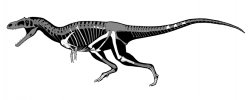Documentary Film On Dinosaurs
 Quentin Cooper BBC Future
Quentin Cooper BBC Future
Image copyright Thinkstock
The dinosaurs are almost the springs of the film itself. However, the version of the appearance of the prehistoric monsters, which is presented on the screen, far from the prehistoric reality, is endorsed by the correspondent BBC Future.
The documentary "Dinosaur 13" is perhaps the most accurate picture of the ancient lizards of all ever filmed. It's one of the most fascinating. The film describes how the Fossil Hunters in South Dakota found the largest and most complete skeleton of the Tyrannosaurus of the rivers from all those ever found. The paleontologists were planning to make their finding the main source of the nearby museum. Instead, there was a struggle around the fossils to possess them, followed by an FBI raid, a trial and a long prison sentence for one of the paleontologists.
The tyrannosaur remains were sold for almost eight million dollars, none of which were received by the authors. The skeleton is now displayed at a private museum in Chicago, almost 1,000 miles from where it was found.
The strength of this documentary film lies in its story, in the history of the real life that underpins it, and how and how we learn about the actors (including the tyrannosaurus itself) and sympathize with them.
Equally important is what is not in the picture. There's no visual image that we're so familiar with movies and dinosaurs TV. There are no computer tyrannosaurus, no animator, mechanisms and electronic devices that force dolls and maquita to move and make noises, no even multiplier creatures or people in monster costumes that can't be seen moving on screen.
Image copyright Getty Image caption director Todd Miller and scientist Peter Larson at the premiere of Dinosaur 13(Dinosaur 13 was based on the largest discovery made by a group of paleontologists led by Pete Larson in 1990 in South Dakota. The female tyrannosaur, whose skeleton was excavated by scientists, called Sue. The U.S. Federal authorities removed the skeleton from Larson, and the scientist himself was convicted for a year and a half for actively preventing the seizure of ancient bones. Pete Larson is the author of dinosaurs scientific work, a book on the history of finding and seizing Sue skeleton, and a book on paleontology and paleontologists for children. Red.









